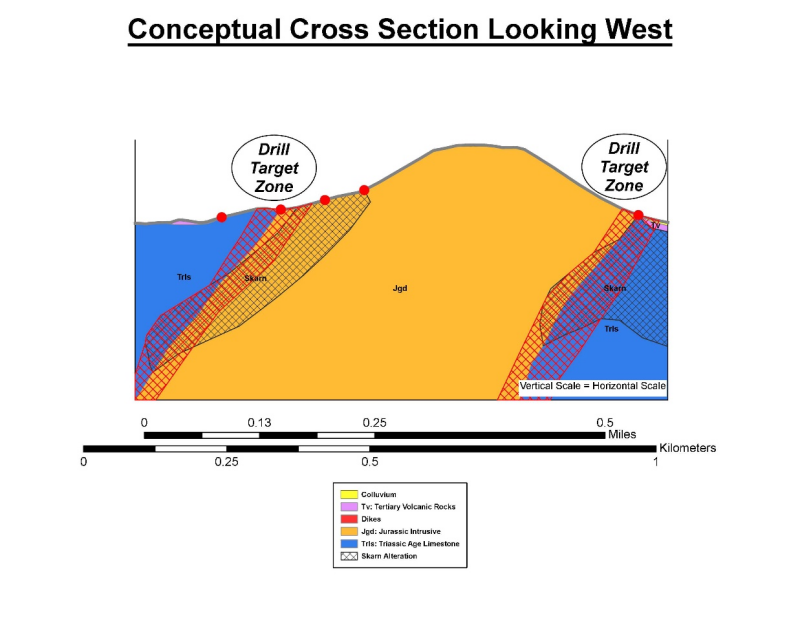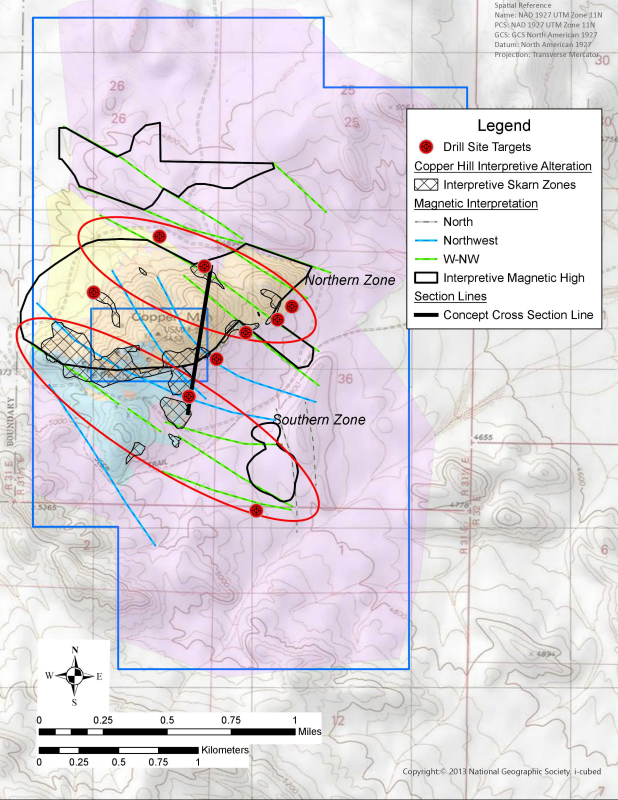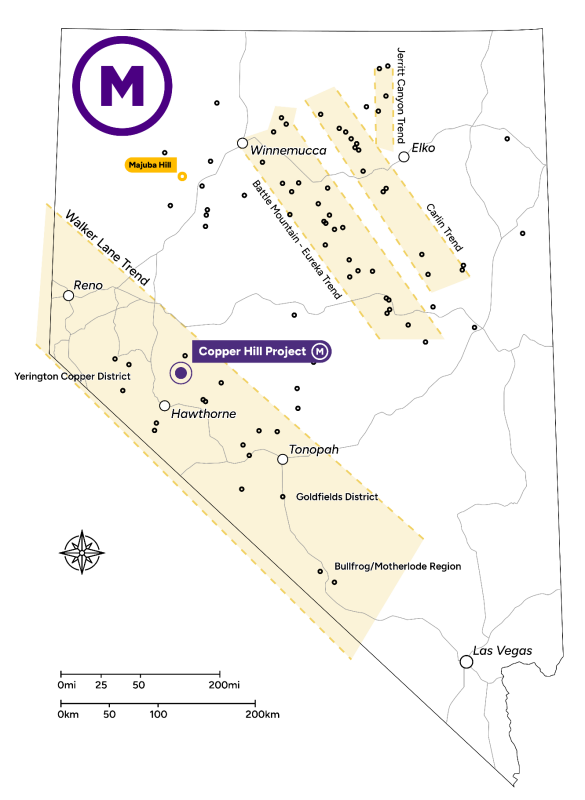Archive
Manning Ventures Provides Drilling Update For Its Copper Hill Project, Nevada, USA
 | |||||||||
Vancouver, British Columbia, August 20, 2024 – TheNewswire – Manning Ventures Inc. (the “Company” or “Manning”) (CSE: MANN; US: MANVF; Frankfurt: 1H5) is pleased to update its shareholders on the initial drill program planning at the Copper Hill Project located within the Walker Lane Trend, southern Nevada, USA.
Plans are underway to drill inclined holes testing the skarn on the contact between the limestone and the intrusive for the Northern and the Southern Zones. The two zones outline target areas which host significant copper values (0.5 to >1.0% copper) in intense skarn alteration. Each zone is over 1500 meters (>5000 feet) long and is defined by prominent gravity and magnetic geophysical signatures as reported previously by Manning.
Specific drill hole locations will be defined utilizing all the data collected, and the historic data accumulated by the Company. Sites will be chosen to drill-test the targets with the most favorable geochemistry, geophysics, and geology.
Specific sites will be permitted with the U.S. Bureau of Land Management. Access and drill sites will utilize the proscribed Notice Level process that allows for up to five (5) acres of disturbance. Once submitted, the Notice Level plan is typically accepted and authorized in less than one month.
The Company anticipates confirming the exact drill locations over the next few weeks and will provide details once the permit application has been submitted.
Image 1: Conceptual Cross Section, Copper Hill Project, Nevada, USA
“Our team is applying a methodical approach to defining priority targets utilizing both historical and recently generated data,” commented CEO, Alex Klenman. “The initial drill campaigns will involve a multi-phased effort over several zones of interest. As drill data is collected, we’ll sharpen the focus to the most prospective areas. We’re certainly eager to begin the next phase of exploration at Copper Hill and look forward to receiving permit approval,” continued Mr. Klenman.
Image 1: Phase one proposed drill targets, Copper Hill Project, Nevada, USA
Recent geological mapping has identified four primary rock units within Triassic Luning limestone which was intruded by a Jurassic igneous complex which was then overlain by Neogene age Volcanic rocks and Quarternary aged unconsolidated gravels. Comparison of the geophysical interpretations and surface geochemical sampling results announced previously with the current geological mapping indicates a series of west-northwest and northwest trending structural fabrics providing the primary controls to copper mineralization at Copper Hill. The northwest faults and associated magnetic and gravity linears represent structural breaks and pathways for mineralizing fluids as witnessed by the elevated copper values returned within these zones.
Skarn-type alteration and mineralization is found throughout the Mesozoic limestone and igneous rocks. It occurs in two prominent geologic settings on the copper hill property see figure 1.
-
Limestone-granodiorite contact
-
Along northwest and west-northwest trending faults and fault zones; dominantly in the Jurassic igneous rocks with less intense, more distal-type skarn-type alteration in the Triassic Luning Limestone.
Mineralization Controls
The mapping and compilation of all exploration data at Copper Hill outlines an untested, highly prospective, copper/gold bearing skarn target. Potential may exist for a porphyry type copper deposit to be found deep beneath Copper Mountain or beneath the covered southeast intrusive. Additionally, porphyry-related veins and local chloritic and sericitic alteration is found along these northwest trends.
Two exploration corridors termed the Northern Zone and the Southern Zone outline areas with over 1500 meters (>5,000 feet) of strike length which host significant, intense skarn alteration and elevated copper values (0.5 to >1.0% copper).
The most significant features on the west-northwest trends are:
-
Northern Zone
1. Correlates with northern copper in soils anomaly
2. Aligns with garnetite, copper-bearing zones
3. Aligns with larger dikes of diorite
-
Southern Zone
1. Adjacent to deepest historic mineralization and proximal to historic shallow, near surface mines (limestone host in historic mine area is likely very thin and gets wider and thicker moving to southeast).
2. Aligns with gravity trend indicating Limestone/intrusive contact connecting southeast to “SE” buried intrusive.
3. Northern end of southern zone associated with high-grade surface sampling and historic mining of garnetite and massive magnetite skarn zones.
4. Correlates with southern high copper in soils anomaly.
Image 3: Location of Copper Hill, Walker Lane Trend, Nevada, USA
About the Copper Hill Project
Located within the prolific Walker Lane trend in southern Nevada, Copper Hill is situated one of the premier jurisdictions for precious metals mining in the world. Historic endowment within Walker Lane includes 50Moz Au, 700Moz Ag, and 4Mt Cu. Copper Hill hosts copper-gold-molybdenum mineralization in both porphyry and skarn styled deposits in Mineral County, Nevada. The property consists of 108 mineral claims covering an area of 893-ha, located 22 miles north of Hawthorne, Nevada and is accessible using well-maintained County Roads.
The Project is centered on a Jurassic Age quartz monzonite porphyry intruding Triassic age Luning Limestone. The claims cover 2.3 sq miles and are 33 miles east of the Yerington Copper District which hosts the Yerington Copper Mine (Anaconda 1952-1978), Ann Mason Deposit, Bear Deposit, MacArthur Deposit, and the Pumpkin Hollow Mine.
Historically at Copper Hill, reported high-grade copper was mined from underground shafts from skarn and porphyry-copper styled mineralization at the Copper Mountain Mine. Between 1914 to 1926 mining from the “Copper Mountain Mine” produced an estimated 1,000,000 pounds of copper from shallow underground workings. Historic reporting from the period of production describes ore zones of contact skarn- type and porphyry-type mineralization with shipping grades ranging from 3.5 to 11.0% copper*.
*Historic Mining information was summarized from an “Unpublished Report on the Carson Sink Area, Nevada by F.C. Schrader, U.S. Geological Survey (Field work 1911-1920) 1947”. Manning Ventures cautions investors that the historic exploration and production information is believed to be accurate but has not been verified by a qualified person.
The Copper Hill mineralizing system forms a topographic high surrounded and partially covered by younger volcanic rocks. Mineralization identified at Copper Hill are bornite, chalcocite, chalcopyrite, chrysocolla, copper-native, covellite, cuprite, gold, malachite, molybdenite, silver, sphalerite (rare), and tetrahedrite.
The Copper Mountain area was explored between 1959 to 1979 by Idaho Minning Corp. and Walker-Martel who conducted ground geophysics, underground mapping, prospecting and reported 6000 feet of Rotary drilling. Since that time ground magnetics were conducted in 2007.
Rock sampling collected at this time returned values from select samples of 7.2% and 12.7% copper and 1.06 g/t gold and 1.19 g/t gold respectively.
Warren Robb P.Geo., is the designated Qualified Person as defined by National Instrument 43-101 and is responsible for the technical information contained in this release.
About Manning
Manning Ventures is a mineral exploration and development company focused metals and materials critical to the growing Energy Metals space. Manning’s project portfolio is focused on Copper in Nevada, Lithium/Copper in Ontario and Quebec, and multiple Iron Ore projects in Quebec.
For further information contact:
Manning Ventures Inc.
Alex Klenman - CEO
Email: info@manning-ventures.com
Telephone: (604) 681-0084
www.manning-ventures.com
FORWARD LOOKING STATEMENTS:
The Canadian Securities Exchange does not accept responsibility for the adequacy or accuracy of this news release.
Certain statements in this press release may contain forward-looking information (within the meaning of Canadian securities legislation), including, without limitation, the Company’s payment of the Exercise Price during the Option Term, the granting of the net smelter return royalty to the Optionor, and the Company’s payment of the annual minimum payments to the Optionor. These statements address future events and conditions and, as such, involve known and unknown risks, uncertainties, and other factors, which may cause the actual results, performance, or achievements to be materially different from any future results, performance, or achievements expressed or implied by the statements. Forward-looking statements speak only as of the date those statements are made. Although the Company believes the expectations expressed in such forward-looking statements are based on reasonable assumptions, such statements are not guarantees of future performance and actual results may differ materially from those in the forward-looking statements. Factors that could cause the actual results to differ materially from those in forward-looking statements include regulatory actions, market prices, and continued availability of capital and financing, and general economic, market or business conditions. Investors are cautioned that any such statements are not guarantees of future performance and actual results or developments may differ materially from those projected in the forward-looking statements. Forward-looking statements are based on the beliefs, estimates and opinions of the Company's management on the date the statements are made. Except as required by applicable law, the Company assumes no obligation to update or to publicly announce the results of any change to any forward-looking statement contained or incorporated by reference herein to reflect actual results, future events or developments, changes in assumptions, or changes in other factors affecting the forward-looking statements. If the Company updates any forward-looking statement(s), no inference should be drawn that it will make additional updates with respect to those or other forward-looking statements.


